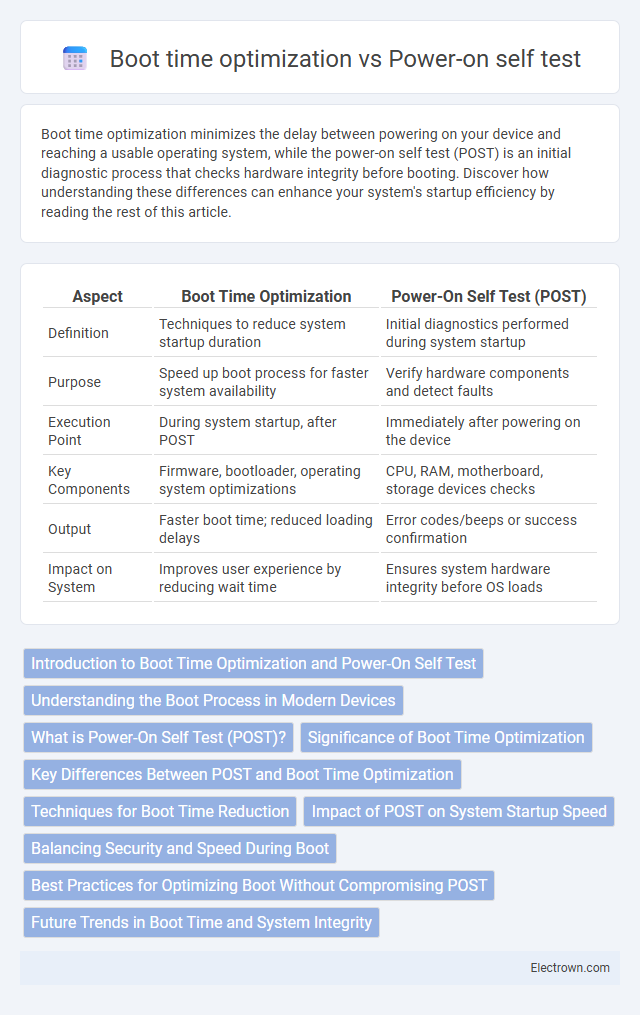Boot time optimization minimizes the delay between powering on your device and reaching a usable operating system, while the power-on self test (POST) is an initial diagnostic process that checks hardware integrity before booting. Discover how understanding these differences can enhance your system's startup efficiency by reading the rest of this article.
Table of Comparison
| Aspect | Boot Time Optimization | Power-On Self Test (POST) |
|---|---|---|
| Definition | Techniques to reduce system startup duration | Initial diagnostics performed during system startup |
| Purpose | Speed up boot process for faster system availability | Verify hardware components and detect faults |
| Execution Point | During system startup, after POST | Immediately after powering on the device |
| Key Components | Firmware, bootloader, operating system optimizations | CPU, RAM, motherboard, storage devices checks |
| Output | Faster boot time; reduced loading delays | Error codes/beeps or success confirmation |
| Impact on System | Improves user experience by reducing wait time | Ensures system hardware integrity before OS loads |
Introduction to Boot Time Optimization and Power-On Self Test
Boot Time Optimization involves reducing the time a computer takes to become operational by streamlining system initialization and loading essential drivers and services efficiently. Power-On Self Test (POST) is a diagnostic process executed by firmware immediately after powering on, verifying hardware components like memory, CPU, and storage devices to ensure system integrity. Both processes are critical for system startup performance, with POST ensuring hardware readiness and Boot Time Optimization enhancing overall startup speed.
Understanding the Boot Process in Modern Devices
Boot time optimization enhances the speed at which modern devices transition from power-on self test (POST) to operating system loading, minimizing the delay experienced during startup. While POST is a critical diagnostic stage that verifies hardware integrity and system configuration, boot time optimization techniques streamline this process by prioritizing essential checks and reducing unnecessary routines. Understanding the interplay between POST and boot time optimization helps you improve device responsiveness and overall system performance.
What is Power-On Self Test (POST)?
Power-On Self Test (POST) is a diagnostic process executed by your computer's firmware immediately after powering on, designed to check hardware components such as memory, disk drives, and motherboard integrity. The efficiency of POST directly influences your device's boot time since thorough tests can delay system startup. Optimizing boot time involves balancing the completeness of POST with faster hardware initialization to enhance overall user experience.
Significance of Boot Time Optimization
Boot time optimization significantly reduces the duration from power-on to system readiness, enhancing user experience and operational efficiency. By streamlining hardware initialization and loading essential software components faster, it minimizes downtime and accelerates productivity in both consumer and enterprise environments. Compared to the Power-On Self-Test (POST), which primarily verifies hardware functionality, boot time optimization focuses on expediting the entire startup sequence for improved overall performance.
Key Differences Between POST and Boot Time Optimization
POST (Power-On Self Test) is an initial diagnostic process that checks hardware components like RAM, CPU, and storage devices for errors before the operating system loads. Boot time optimization involves techniques such as disabling unnecessary startup programs, optimizing firmware settings, and using SSDs to reduce the overall time from power-on to OS readiness. While POST ensures system hardware integrity, boot time optimization focuses on minimizing the delay after POST completion to enhance user experience.
Techniques for Boot Time Reduction
Techniques for boot time reduction focus on minimizing the duration from power-on to operating system readiness by streamlining the Power-On Self Test (POST) process. Methods include optimizing firmware code, enabling Fast Boot modes that skip non-essential hardware checks, and prioritizing device initialization based on system-critical components. Implementing parallel hardware initialization and leveraging advanced BIOS/UEFI settings significantly contributes to faster boot sequences without compromising system stability and diagnostics.
Impact of POST on System Startup Speed
Power-On Self Test (POST) is a critical diagnostic process that ensures hardware components are functioning correctly before the operating system loads, directly influencing system startup speed. Extensive POST checks increase boot time by thoroughly validating memory, CPU, and peripheral devices, while optimized POST routines prioritize essential tests to reduce delays. You can improve boot time by configuring POST settings in BIOS/UEFI to balance between thorough system validation and faster startup.
Balancing Security and Speed During Boot
Boot time optimization reduces system startup duration by streamlining processes, yet maintaining thorough power-on self tests (POST) ensures hardware integrity and security. Balancing security and speed during boot relies on selectively prioritizing critical POST checks while deferring non-essential diagnostics to accelerate readiness without compromising system reliability. Integrating adaptive POST sequences with fast boot technologies enables efficient startups that uphold robust security protocols.
Best Practices for Optimizing Boot Without Compromising POST
Optimizing boot time requires minimizing delays while preserving the integrity of the Power-On Self Test (POST), which verifies hardware health and system functionality. Best practices include selectively disabling non-essential POST checks, enabling fast boot options in BIOS settings, and updating firmware to reduce POST duration without skipping critical diagnostics. Maintaining a balance ensures rapid startup times while preventing hardware failures and ensuring system stability.
Future Trends in Boot Time and System Integrity
Future trends in boot time optimization emphasize reducing startup latency through advanced predictive caching, parallelized initialization processes, and firmware enhancements utilizing machine learning algorithms. Power-on self test (POST) systems are evolving to include more comprehensive hardware diagnostics and security checks embedded within UEFI firmware to ensure system integrity against firmware attacks and hardware failures. Integration of Trusted Platform Modules (TPM) and secure boot protocols further strengthens boot-time validation, enhancing both speed and reliability in modern computing environments.
Boot time optimization vs power-on self test Infographic

 electrown.com
electrown.com